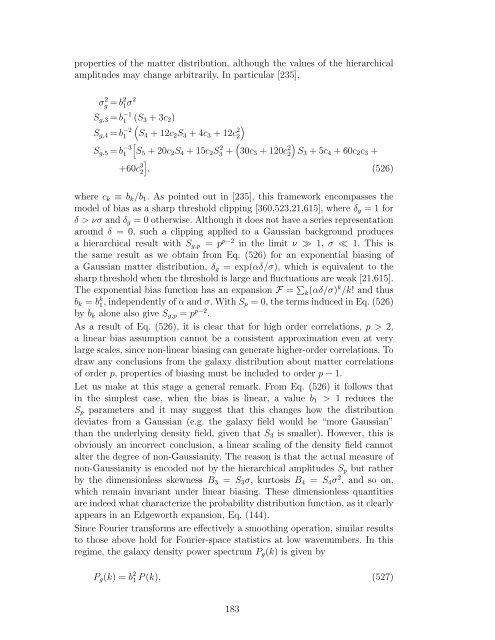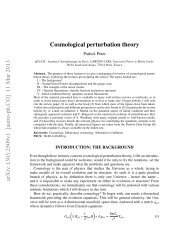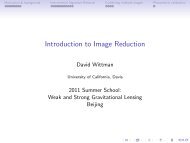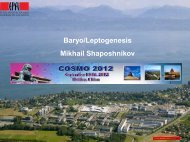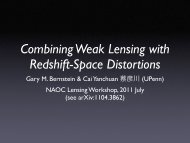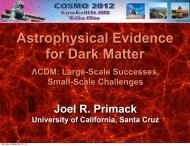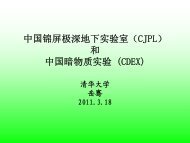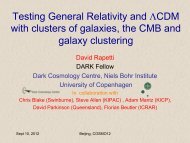Large-Scale Structure of the Universe and Cosmological ...
Large-Scale Structure of the Universe and Cosmological ...
Large-Scale Structure of the Universe and Cosmological ...
You also want an ePaper? Increase the reach of your titles
YUMPU automatically turns print PDFs into web optimized ePapers that Google loves.
properties <strong>of</strong> <strong>the</strong> matter distribution, although <strong>the</strong> values <strong>of</strong> <strong>the</strong> hierarchical<br />
amplitudes may change arbitrarily. In particular [235],<br />
σ 2 g =b2 1 σ2<br />
Sg,3 =b −1<br />
1 (S3 + 3c2)<br />
Sg,4 =b −2<br />
<br />
1 S4 + 12c2S3 + 4c3 + 12c 2 <br />
2<br />
Sg,5 =b −3<br />
<br />
1 S5 + 20c2S4 + 15c2S 2 3<br />
+60c 3 <br />
2<br />
+ <br />
30c3 + 120c 2 2<br />
<br />
S3 + 5c4 + 60c2c3 +<br />
, (526)<br />
where ck ≡ bk/b1. As pointed out in [235], this framework encompasses <strong>the</strong><br />
model <strong>of</strong> bias as a sharp threshold clipping [360,523,21,615], where δg = 1 for<br />
δ > νσ <strong>and</strong> δg = 0 o<strong>the</strong>rwise. Although it does not have a series representation<br />
around δ = 0, such a clipping applied to a Gaussian background produces<br />
a hierarchical result with Sg,p = p p−2 in <strong>the</strong> limit ν ≫ 1, σ ≪ 1. This is<br />
<strong>the</strong> same result as we obtain from Eq. (526) for an exponential biasing <strong>of</strong><br />
a Gaussian matter distribution, δg = exp(αδ/σ), which is equivalent to <strong>the</strong><br />
sharp threshold when <strong>the</strong> threshold is large <strong>and</strong> fluctuations are weak [21,615].<br />
The exponential bias function has an expansion F = <br />
k(αδ/σ) k /k! <strong>and</strong> thus<br />
bk = b k 1, independently <strong>of</strong> α <strong>and</strong> σ. With Sp = 0, <strong>the</strong> terms induced in Eq. (526)<br />
by bk alone also give Sg,p = p p−2 .<br />
As a result <strong>of</strong> Eq. (526), it is clear that for high order correlations, p > 2,<br />
a linear bias assumption cannot be a consistent approximation even at very<br />
large scales, since non-linear biasing can generate higher-order correlations. To<br />
draw any conclusions from <strong>the</strong> galaxy distribution about matter correlations<br />
<strong>of</strong> order p, properties <strong>of</strong> biasing must be included to order p − 1.<br />
Let us make at this stage a general remark. From Eq. (526) it follows that<br />
in <strong>the</strong> simplest case, when <strong>the</strong> bias is linear, a value b1 > 1 reduces <strong>the</strong><br />
Sp parameters <strong>and</strong> it may suggest that this changes how <strong>the</strong> distribution<br />
deviates from a Gaussian (e.g. <strong>the</strong> galaxy field would be “more Gaussian”<br />
than <strong>the</strong> underlying density field, given that S3 is smaller). However, this is<br />
obviously an incorrect conclusion, a linear scaling <strong>of</strong> <strong>the</strong> density field cannot<br />
alter <strong>the</strong> degree <strong>of</strong> non-Gaussianity. The reason is that <strong>the</strong> actual measure <strong>of</strong><br />
non-Gaussianity is encoded not by <strong>the</strong> hierarchical amplitudes Sp but ra<strong>the</strong>r<br />
by <strong>the</strong> dimensionless skewness B3 = S3σ, kurtosis B4 = S4σ 2 , <strong>and</strong> so on,<br />
which remain invariant under linear biasing. These dimensionless quantities<br />
are indeed what characterize <strong>the</strong> probability distribution function, as it clearly<br />
appears in an Edgeworth expansion, Eq. (144).<br />
Since Fourier transforms are effectively a smoothing operation, similar results<br />
to those above hold for Fourier-space statistics at low wavenumbers. In this<br />
regime, <strong>the</strong> galaxy density power spectrum Pg(k) is given by<br />
Pg(k) = b 2 1 P(k), (527)<br />
183


